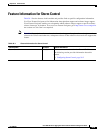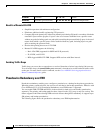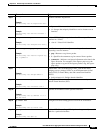
39-4
Cisco ASR 901 Series Aggregation Services Router Software Configuration Guide
OL-23826-09
Chapter39 Remote Loop-Free Alternate - Fast Reroute
Feature Overview
Benefits of Remote LFA-FRR
• Simplifies operation with minimum configuration
• Eliminates additional traffic engineering (TE) protocols.
• Computes PQ node dynamically without any manual provisioning (PQ node is a member of both the
extended P-space and the Q-space. P-space is the set of routers reachable from a specific router
without any path (including equal cost path splits) transiting the protected link. Q-space is the set of
routers from which a specific router can be reached without any path, including equal cost path
splits, transiting the protected link.)
• Prevents hair pinning that occurs in TE-FRR
• Remote LFA-FRR supports the following:
–
Basic LFA-FRR (supported for OSPF and IS-IS protocols)
–
IP, L2VPN, and L3VPN
–
BFD triggered MPLS TE-FRR. Supports BFD sessions with 50ms interval.
Avoiding Traffic Drops
Traffic drops can occur due to congestion as a result of formation of micro loops during link recovery.
To avoid traffic drops, the tunnel-buffer port command is introduced to set the hardware buffer values
on the port. For more details on this command, see the Cisco ASR 901 Series Aggregation Services
Router Command Reference guide.
Pseudowire Redundancy over FRR
Pseudowire redundancy enables you to configure a pseudowire as a backup for the primary pseudowire.
When the primary pseudowire fails, the services are switched to the backup pseudowire. Effective with
Cisco IOS Release 15.4(1)S, Pseudowire Redundancy over FRR feature is supported.
You can enable FRR (TE-FRR and RLFA) in the network for both active and standby pseudowires
separately. The primary and backup paths for these virtual circuits (VCs) may or may not overlap. This
feature supports link failures through FRR and node failures through PW redundancy. It supports up to
500 primary and backup pseudowires.
The following figure shows the pseudowire redundancy over FRR implementation.
R1 and R7 CE nodes R6 - R5 - R4 P nodes
R2 and R3 PE nodes (protected link) R2 - R4- R5 - R6 - R3 Fast Reroute Repair Path


















